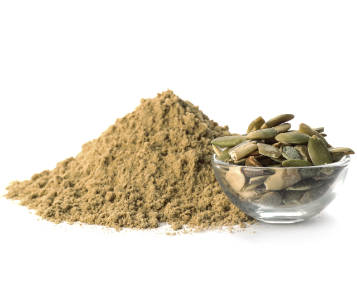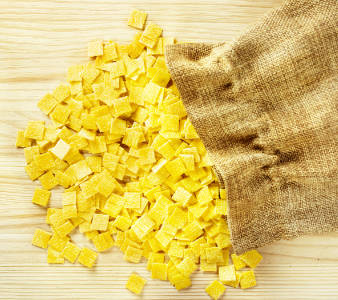Grain Products Category

Includes flour, noodles, and dough.
pasta al ceppo
This means "pasta on a stick" in Italian, and this tubular pasta was originally made by wrapping dough around knitting needles.
Learn morePasta Ribbons
Ribbons of pasta are usually available either fresh or dried. Use fresh ribbon pasta for light, delicate sauces and dried for the rich, heavier ones.
Learn morePasta Rods
Long strands of pasta are challenging to eat, and that's part of their charm. Medium-sized rods like spaghetti are normally served with light tomato-based sauces. Thin rods like angel hair pasta and vermicelli work best in broths or with thin sauces, while thicker rods like perciatelli go well with heavier, chunkier sauces. Rods are best if they're served immediately after being cooked. If you're planning to serve a lot of people, consider using small pasta tubes or shapes.
Learn morepasta sheet
Use this sheet of fresh pasta in place of lasagna, or to make your own stuffed pasta. You can sometimes buy it where fresh pasta is made in-house.
Learn morePasta Tubes
With their thick walls, tubular pasta like penne and macaroni are ideal for pasta salads, thick sauces, and casseroles. Long tubes like perciatelli are often served with sauces, or they're broken up and used in soups. Large, wide tubes like cannelloni and manicotti are stuffed and baked. Tubes with grooves on the exterior, denoted by the Italian adjective "rigati" or "rigate" after the pasta's name, do a better job of holding sauces. Smooth-walled pasta is called "lisci" or "lisce."
Learn morepatty shell
These are small cups made of puff pastry that are meant to hold individual portions of savory fillings. Look for them in bakeries or among the frozen foods in supermarkets.
Learn morepectin
In order to make preserves like jams and jellies, you normally cook together fruit, acid, sugar, and pectin, a substance found in certain fruits that gels when heated. Some fruits -- like quinces, gooseberries, tart apples, and sour plums -- contain enough natural pectin that they'll thicken all by themselves into preserves. Others, like cherries and some berries, need an extra boost to firm up. Jam recipes for pectin-deficient fruit normally call for liquid or powdered pectin, which you can find among the baking supplies in most supermarkets. The recipes usually specify what brand of pectin to use, and it's not a good idea to substitute one brand for another, since they have different formulas. Some brands (like Sure Jell and Certo) need acid and sugar to set, some (like Sure Jell for Low Sugar Recipes) need acid and just a little sugar to set, some (like Pomona's Universal Pectin® or Mrs. Wages Lite Home Jell Fruit Pectin®) don't need any sugar to set. Liquid pectin contains sulfite, which can cause an allergic reaction in people with sulfite sensitivites, but powdered pectin does not.
Learn morepenne
This Italian pasta consists of short tubes cut on the diagonal, the better to scoop sauces inside. It's very versatile, and works well mixed with a sauce, or in a casserole, soup, or pasta salad. Penne rigate has ridges, the better to hold sauces. Penne lisce has smooth walls.
Learn moreperciatelli
These are hollow pasta rods that are thicker than spaghetti. They're usually served in casseroles or with hearty meat sauces, or they're broken up and served in minestrone soup.
Learn morephyllo
These are fragile, paper-thin sheets of dough that are usually basted with melted butter and then stacked until they're many layers thick. When baked, the combined layers make a rich, flaky, and crumbly crust. Greeks use phyllo dough to make baklava and spanakopita, while phyllophiles elsewhere use it to make pie crusts, strudels, Beef Wellington, egg rolls, and countless other concoctions. Some cooks use cooking spray instead of butter between the layers to trim fat and calories. The dough dries out quickly, so work fast once you've opened the package, and cover any unused dough with plastic wrap topped with a damp towel. Use fresh dough if you can find it; it doesn't tear as easily as the frozen kind. The frozen version is often wedged near the pie shells in the supermarket's frozen food case; let it defrost in the refrigerator for 24 hours before using it. Try Greek or Middle Eastern markets for fresh.
Learn morepie pastry
This pie dough is easy enough to make at home, or you can find it ready-made among the frozen foods of most supermarkets.
Learn morepoi
Hawaiians make this out of taro root, which is cooked, pounded into a paste, and then sometimes fermented. It's somewhat bland, and usually served as an accompaniment to other foods, much like mainlanders serve mashed potatoes.
Learn morepolenta
This Italian specialty is made of cornmeal that's been cooked into a thick mush. The mush is either served hot, much as Americans would serve mashed potatoes, or it's cooled, sliced, and then fried, grilled, or baked. It's easy to make at home, or you can get tubes of ready-made polenta in the refrigerated section of many supermarkets.
Learn morepotato starch
This gluten-free starch is used to thicken soups and gravies. Its main advantage over other starch thickeners is that it's a permitted ingredient for Passover, unlike cornstarch and other grain-based foods. Liquids thickened with potato starch should never be boiled. Supermarkets often stock it among the Kosher products.
Learn morepotsticker wrappers
These small, thick wrappers are stuffed with meat fillings, and then pan-fried and steamed. While assembling the potstickers, keep the stack of wrappers moist by covering them with a damp towel. You can seal the potstickers with a "glue" made with cornstarch and water. Look for stacks of them wrapped in plastic in the refrigerator cases of Asian markets. They freeze well.
Learn morepraline powder
This is used to flavor ice cream and pastry fillings. It's made from pralines, a crunchy French candy that resembles peanut brittle, except that it's made with almonds or hazelnuts. You can buy praline powder ready made, but it's easy to make your own by pulverizing praline pieces in a food processor. Be sure to use crunchy pralines, not the soft pecan candies that people in New Orleans call pralines.
Learn morepuff pastry dough
This is dough topped with chilled butter that's rolled out and folded again and again until there are hundreds of layers of butter and dough. The dough expands and the layers separate when it's baked, creating a marvelously rich and flaky pastry. Puff pastry is used to make croissants, Napoleons, Beef Wellington, pie crusts, and many other sweet and savory pastries. You can make puff pastry yourself, but it's hard to improve on the ready-made stuff sold in the frozen foods section of many supermarkets. Let frozen puff pastry defrost for about 30 minutes before you roll it out, but don't let it get too warm or it will become sticky.
Learn morequinoa pasta
This is a high-protein pasta alternative for people with wheat allergies. It may contain corn flour as well.
Learn moreradiatori
A type of Italian pasta, these resemble small radiators. The "grills" do a good job of scooping up chunky sauces.
Learn moreramen
A staple of Japanese salarymen and American college students, these Japanese noodles can be used in soups or salads. You can find bricks of instant ramen in many supermarkets, packaged in cellophane along with seasoning packets which you can use or discard. These noodles are usually fried in oil before they're dried, so they tend to be high in fat. They cook in about 2 to 3 minutes. Asian stores also carry fresh or frozen ramen noodles.
Learn moreravioli
These are small, square pillows of stuffed pasta that are often served with a light sauce. The traditional filling is ricotta cheese mixed with spinach or some other cooking green, but adventurous cooks have used wild mushrooms, sweet potatoes, winter squash, goat cheese, lobster, nuts, and even prunes. Ravioli are usually topped with a tomato or cream sauce, or with grated cheese. Don't overcook them or they'll fall apart. Smaller ravioli are called ravioletti, and a single one is called a raviolo.
Learn morereginelle
These pasta tubes are similar to penne, though a bit longer and thinner. The name reginelle is also sometimes used for reginette pasta, which are wide ribbons with ruffled edges.
Learn morerice flake noodles
These big, flat rice noodles look like tortilla chips. They're used in soups and stir-fries. Before using them, soften them in hot water, then boil or stir-fry them briefly, usually not more than a minute.
Learn morerice flour
To see how to substitute other flours for wheat flours, see the listing under all-purpose flour.
Learn morerice noodles
Rice noodles are made with rice flour, and are especially popular in Southeast Asia. It's easy to find dried rice noodles in large supermarkets, but you'll probably have to visit an Asian market to find them fresh. Rice noodles should be soaked in hot water before using. When they're soft and transparent, drain them.
Learn morerice paper
These thin, fragile sheets are used to make spring rolls, but they also make good all-purpose wrappers, baking pan liners, and even lasagne noodles. The sheets are brittle, so you need to moisten them with water before wrapping foods in them. Keep them moist while you work with them by covering the stack with a damp towel. Rice paper doesn't need to be cooked, but it's sturdy enough to be steamed or deep-fried. Look for it in Asian markets. It can be stored in a cool, dark place for many months.
Learn morerice pasta
This is a good pasta alternative for people with wheat allergies. It's also available as brown rice pasta.
Learn morerice sticks
They come in many shapes and sizes, but they can be roughly classified as thin, medium, and wide. Thin rice noodles are used in soups, salads, and spring rolls. Medium noodles are the most versatile, and can be used in soups, stir-fries, salads, or as a bed for meat or fish. Wide noodles are best used in soups, stir-fries, and braised dishes. Before using rice noodles, soften them in hot water. This will take anywhere from a few minutes to a half hour, depending upon the thickness of the noodles. After they've softened, boil or stir-fry them briefly, usually not more than a minute. It's easier to stir-fry noodles if you break them into shorter lengths.
Learn morerice vermicelli
These are used throughout Asian in soups, spring rolls, cold salads, and stir-fries. They're similar to bean threads, only they're longer and made with rice flour instead of mung bean starch. Before using, soak the dried noodles in hot water until they're soft (about 15 minutes), then boil them briefly (from 1 to 3 minutes) and rinse with hot water. You can also deep-fry the dried noodles until they're crunchy and then use them in Chinese chicken salad, or as a garnish or bed for sauces.
Learn morerigatoni
These are big pasta tubes with ridges. They're normally served with chunky sauces or baked in casseroles.
Learn more










































































































































































































































































































































































